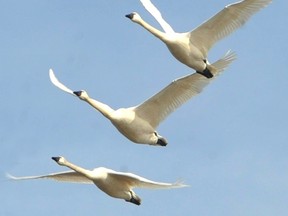Rare Tundra Swans spotted on Bonnechere River

Article content
The first rare bird of this spring migration was reported by Rick O’Brien of the Golden Lake area on March 14. Both Rick and his wife spotted a pair of Tundra Swans on the Bonnechere River in front of their home. The sighting was confirmed by Manson Fleguel who thought that the swans may actually be Trumpeter Swans. The only way to differentiate these birds for sure is by a close examination of their bills, or, by their distinctive calls. The mystery was resolved a couple of days later when Ron Bertrand and Vic Harmer of Pembroke heard the swans calling and were able to determine that they were, indeed, Tundra Swans.
Tundra Swans are presently passing through Ontario in large numbers, especially in the Aylmer, Ontario, area. The odd swan strays east from this mass migration, and if we are lucky, someone will observe it in our area. This also occurs occasionally during the fall migration. The sighting of wild swans is always exciting!
The Tundra Swan (Cygnus columbianus) is our most common swan and the most widespread in North America. It was formerly known as the Whistling Swan.
This swan is a large bird of about 53 inches with a wingspan of six to seven feet. It is all white, and like all swans, has a large, long neck. This swan has a black beak with a concave profile and often has a yellow basal spot.
This bird likes to reside in the northern Tundra during the summer. However, in all seasons and during migration, they can be seen on lakes, large rivers, bays, estuaries and even flooded fields.
The Tundra Swan is an exceptional swimmer. In order to eat, it likes to dab its head and neck below the water and feed on aquatic vegetation and roots.
This swan mates for life and has only one brood per year. The nest is normally found near open water or on an island and consists of a low mound of plant material such as mosses, dried grasses, or sedges.
The Tundra Swan is a solitary nester. The female incubates her eggs for a period of 31-40 days. Once hatched, both parents tend to the young. The young experience their first flight at 60-70 days.
This swan breeds from the Arctic Coast to the Alaska Peninsula and other Tundra barren areas throughout the north. It migrates to, and winters in, both the east and west coasts of the United States. It is an occasional visitor to our area during both the spring and fall migrations.
On the local scene, the cold and snowy weather last week delayed most of the first wave of spring birds. However, I suspect that with this week’s change in weather, we should get more reports of Robins and Starlings, Red-winged Blackbirds, Killdeer, Common Grackles, possible Turkey Vultures, American Woodcock, and Eastern Phoebes. There are also some open patches on the Ottawa River and already some of the ducks are accumulating in pockets. The three most obvious species are Mallards, Hooded Mergansers, and Canada Geese. These three species are usually the first waterfowl to arrive in the spring. Also, keep an eye out for the Ring-billed Gulls that should be arriving now. This is a great time for bird watching!
On March 17, I received an anonymous report from Patricia Street informing me that they had a Robin in their yard, their first of the season!
On March 21, John Meadows of Westmeath sent me a picture of a small group of ducks swimming near Westmeath Park. Unfortunately, the ducks were quite far out and impossible to identify. Sounds like more species of ducks may be back than I thought!
On March 22, Liz Link of Barron Canyon Road informed me that she had three Red-winged Blackbirds at her bird feeders. Around this same period, Anne Jones of Sandy Beach Road also reported that she too had a Red-winged Blackbird at her feeder. It is good to hear that they are finally arriving!
Finally, around this same period, Glenda Duff informed me that she still has her Red-bellied Woodpecker coming to her bird suet. She has had this rare woodpecker since December. I am so pleased to hear that it has survived the winter. Glenda also reported that she had a lone Cardinal coming to her feeder for most of the winter. Two nice birds, Glenda!
Please call me with your spring sightings at 613-735-4430 or e-mail me at hooles@bell.net . For more information on nature and the Pembroke and Area Field Naturalists events, I refer you to their website at www.pafn.on.ca .